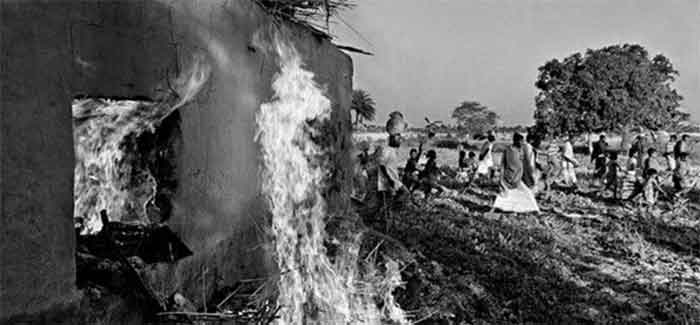
In view of the prevalent political deadlock, growth-oriented economic development, or growth-without-development – which is simultaneously stagnating and misleading due to inflated GDP growth estimate by the Government – and the absence of the rule of law and accountability of the government, especially since 2007, Bangladesh finds itself in a political cul-de-sac. Why so? The prevalent stalemate under a one-party dictatorship, which abducts and executes dissidents and suspected “troublemakers” through extra-judicial means (only the fortunate few returns alive) is only comparable with what Germany and Italy went through in the 1930s-1940s, and Bangladesh during its Liberation War in 1971. While scholars and laymen having exposure to the history of Bangladesh during the colonial and postcolonial periods, and even those who grew up in the country during the first twenty years after the Liberation, are often optimistic about the future of the country. They think since Bengalis fought against all odds – against nature and bad rulers – in the past, particularly against the British colonial rule, oppressive elites, landlords and moneylenders, and last but not least, against the Pakistani occupation Army, Mujib’s proto-Gestapo forces, and Ershad’s corrupt autocracy, people’s resilience will pay off at the end of the day.
One is not sure if the Bangladeshi nation will repeat its glorious history! One believes the qualitative differences between the Bangladeshis in the not-so-distant past up to the 1990s (when dictator Ershad was toppled by a peaceful mass movement) and their counterparts today are the countervailing factors in the 2020s. We know to hope for a change for the better inspires people to fight, sacrifice, and win at the end. The bulk of the people in what is Bangladesh today fought the British, Pakistanis, and indigenous autocrats up to the 1990s. However, they were disillusioned again and again. As Pakistan disappointed them so did the corrupt regimes in post-Liberation Bangladesh. Once bitten twice shy! Meanwhile, there have been some major qualitative changes in the demography of the country. There has been a substantial youth bulge, around 40 per cent of the population are in the age-group of 18 and 29. Then again, thanks to the rapid and sharp qualitative decline in the standard of higher education since the fast adoption of Bengali as the medium of college education under the Ershad regime, the overwhelming majority of Bangladeshi college/university graduates from Bengali medium institutions are simply not employable in the private sector (where the employees’ efficiency is the prime concern of the employers). No wonder, tens of thousands of skilled Indians work in Bangladesh and remit several billion dollars to India out of Bangladesh!
The World Bank in its 2019 Report has revealed some distressing and frightening statistics with regard to the rate of unemployment among university graduates from the affiliated colleges of the National University, whose proficiency in English is next to zero. As of March 2019, their unemployment rate is 46 per cent, over two million job seekers enter the market every year. There has been a mass exodus of bright students and almost all the children from the well-to-do classes in the country, who can afford to leave Bangladesh as students and/or prospective employees in North America, Europe, Australia, and elsewhere. Although we do not have any correct statistics, one may assume the number of employable and/or students educated in the English medium schools and universities who are abroad should be in the multiple millions. They are both economic and political immigrants, who are least likely to come back to their motherland to ever live there permanently. So, the country, in short, is infested with the crises of gainful employability of bright people, governance, and security. Those who could change the system by overthrowing the fascistic one-party regime are either out of the country/waiting for their exit visa or are suffering the pain of unemployment and under-employment. Millions of these young people are either drug-addicted or desperately competing against each other for scarce job opportunities. Many of them have joined organized criminal groups and/or the ruling party as activists for making quick money through extortion and corrupt means by using the law-enforcers as their shield. The youths, like their parents and other senior family members, are fast getting thoroughly immoral and degenerated.
And, we know, immoral people neither have the wherewithal nor the will to change society for a better future! Thus, any equation of economic crisis and lack of security of life, honour and property with corresponding social unrest, rebellion, or revolution in Bangladesh is bound to be an oversimplified one! The country during the post-Zia period, on the one hand, has more wealth, much higher GDP growth rate than ever before in the last 200-odd years, and a much higher rate of literacy as well; but on the other, the absolute and proportionate numbers of educated people in the country have declined tremendously since the 1980s. Thus, for the honest and patriotic people, hopelessness has replaced hope, and escapism and fear have replaced their resilience and will to change for the better. Only someone with a crystal ball might be able to tell us what is in store for Bangladesh, which is one of the most over-populated, backward, and underdeveloped countries in the world, in the coming decades! Meanwhile, thanks to absolute degeneration and dysfunctionality in every sphere of society, seemingly, people have become totally insensitive to rampant corruption and human rights violation by law-enforcers or ruling party activists. Bangladesh today – despite high GDP growth due to the income generated by garment factories’ slave labour and ill-paid expatriate workers abroad is comparable with any dysfunctional country in the world.
Taj Hashmi PhD, FRAS is a former Professor of Asian Studies at the UBC (Canada), and Security Studies at the APCSS (US). He is a historian, cultural anthropologist, and political analyst of global security and current affairs. He has authored hundreds of journal articles/popular essays, and several books, including Global Jihad and America (SAGE 2014).
SIGN UP FOR COUNTERCURRENTS DAILY NEWSLETTER
















































